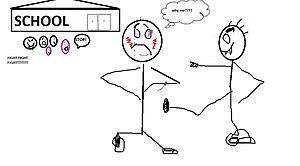| this is my own version of what bullying looks like (Photo credit: Wikipedia) |
Bullying remains the hottest of hot button issues in special education law. We interrupted the series for my thoughts on the Rowley standard as applied to bullying cases. Now we are back
In the first installment of this series, I explained the early cases laying the conceptual groundwork for the proposition that failure to react to bullying can constitute a denial of FAPE under IDEA. In later installments, I have discussed the seminal decision of TK & SK ex rel LK v. New York City Dept of Educ 779 F.Supp.2d 289, 56 IDELR 228 (E.D.N.Y. 4/25/2011). This case is important not just because it analyzes special education law principles involving bullying, but also because it provides a thorough review of the social science literature on bullying. You should read this case and you can do so here.
Here is more from the court...these are not my words:
5. Bullying and Students With Disabilities
The United States Department of Education has defined disability harassment as "intimidation or abusive behavior based on
disability that creates a hostile environment." U.S. Dep't of Educ., Reminder of Responsibility Under Section 504 of the Rehabilitation Act of 1973 and Title II of the Americans with Disabilities Act July, 25 2000, available at http://www2.ed.gov/about/offices/list/ocr/docs/disabharassltr.html (hereinafter DOE Reminder of Responsibilities Letter). Studies have shown that students with a disability, whether it is visible or non-visible, are subject to increased bullying that is often directed at the disability. John Young, Ari Ne'eman, and Sara Gelser, Bullying and Students With Disabilities, in White House Conference on Bullying Prevention, at 74 (March 10, 2011), available at http://www.stopbullying.gov/references/white_house_conference/index.html. These students are also at more risk for bullying directed at factors other than their disability. Id. at 77. Harassing conduct may take many forms, including verbal acts and name-calling, as well as nonverbal behavior, such as graphic written statements, or conduct that is physically threatening, harmful, or humiliating. DOE Reminder of Responsibilities Letter, supra.
[ 779 F.Supp.2d 303 ]
| [ 779 F.Supp.2d 303 ] |
disability that creates a hostile environment." U.S. Dep't of Educ., Reminder of Responsibility Under Section 504 of the Rehabilitation Act of 1973 and Title II of the Americans with Disabilities Act July, 25 2000, available at http://www2.ed.gov/about/offices/list/ocr/docs/disabharassltr.html (hereinafter DOE Reminder of Responsibilities Letter). Studies have shown that students with a disability, whether it is visible or non-visible, are subject to increased bullying that is often directed at the disability. John Young, Ari Ne'eman, and Sara Gelser, Bullying and Students With Disabilities, in White House Conference on Bullying Prevention, at 74 (March 10, 2011), available at http://www.stopbullying.gov/references/white_house_conference/index.html. These students are also at more risk for bullying directed at factors other than their disability. Id. at 77. Harassing conduct may take many forms, including verbal acts and name-calling, as well as nonverbal behavior, such as graphic written statements, or conduct that is physically threatening, harmful, or humiliating. DOE Reminder of Responsibilities Letter, supra.
Overall, students with disabilities are less popular, have fewer friends, and struggle more with loneliness and peer rejection, increasing the likelihood they will become the victim of bullying. Carter, supra, at 12-21 (noting a study that indicated child with even mild learning disorder had fewer friends and another that indicated those who are bullied are more likely to be alone at play time); Young, supra, at 74 ("Many students with disabilities have significant social skills challenges, either as a core trait of their disability or as a result of social isolation due to segregated environments and/or peer rejection. Such students may be at particular risk for bullying and victimization."). Students who suffer from learning disabilities and emotional disorders often lack social awareness, which makes them more vulnerable. Carter, supra, at 12. Other research concludes that disabled students themselves are more likely to perpetuate bullying behavior in response to being bullied. Swearer, supra, at 4.
Despite an increased focus in recent years on instructing special education students in general education classrooms, there has not been a corresponding concern about the way these children integrate socially in the classroom. Carter, supra, at 11. Without healthy social interaction, students with disabilities become targets of harassment.
One study found that four factors were predictive of a student being bullied: 1) receiving extra help in school; 2) being alone at playtime; 3) having fewer than two friends; and 4) being male. Id. at 14. While disabled students often receive extra help, they sometimes struggle to make friends. In one study, learning disabled children reported that they were threatened, assaulted, or had their possessions taken away from them with greater frequency than non-learning disabled students. Id. at 18.
Some states have recognized that students who suffer from a learning disability are at a greater risk for bullying than their non-disabled peers and that IEPs should take this into account. In passing a comprehensive law dealing with school bullying, Massachusetts recently adopted the following requirement:
Whenever the evaluation of the Individualized Education Program team indicates that the child has a disability that affects social skills development or that the child is vulnerable to bullying, harassment or teasing because of the child's disability, the Individualized Education Program shall address the skills
and proficiencies needed to avoid and respond to bullying, harassment or teasing.
[ 779 F.Supp.2d 304 ]
| [ 779 F.Supp.2d 304 ] |
and proficiencies needed to avoid and respond to bullying, harassment or teasing.
Mass. Senate No. 2404 (2010) (emphasis added).
Massachusetts Advocates for Children sought to determine how often children along the autism spectrum are harassed at school. Eighty-eight percent of those parents who responded indicated their child was bullied while at school. Massachusetts Advocates for Children, Targeted, Taunted, Tormented: the Bullying of Children with Autism Spectrum Disorder 2 (2009), available at http://www.massadvocates.org/documents/Bullying-Report.pdf. (finding that verbal harassment was the most common form reported at 88.7 percent).









